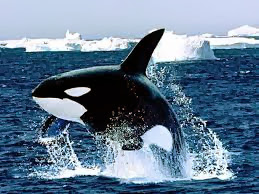"The Sea Creature of the Week"
The Killer Whale or Orca
Orcinus orca
With all the controversy going on with the #Blackfish documentary, I wanted to post about the sea creature behind the story. Killer whales are related to dolphins and are one of the most powerful predators in the ocean. With males reaching 32 feet and 22,000 pounds and females 28 feet and 16,500 pounds, they are the most widely distributed marine mammal, being found in all parts of the oceans. Besides being very intelligent they are also highly social animals, traveling in pods, of up to 40-50 individuals. During social activity, sounds are made and believed to be a form of communication between killer whales. Their diet is largely depended on where they live, but ranges from various species of fish to other marine mammals such as seals, sea lions, and walruses. Posted below are pics of these amazing creatures....but what I'm interested in hearing are your thoughts on marine mammals, such as killer whales, being held in captivity (amusement parks)? There are several opinions and facts that can be discussed....I want to hear yours! Leave a comment and tell me how you feel!!
A documentary showed on CNN of killer whales held in captivity. Watch it and tell me your thoughts!














